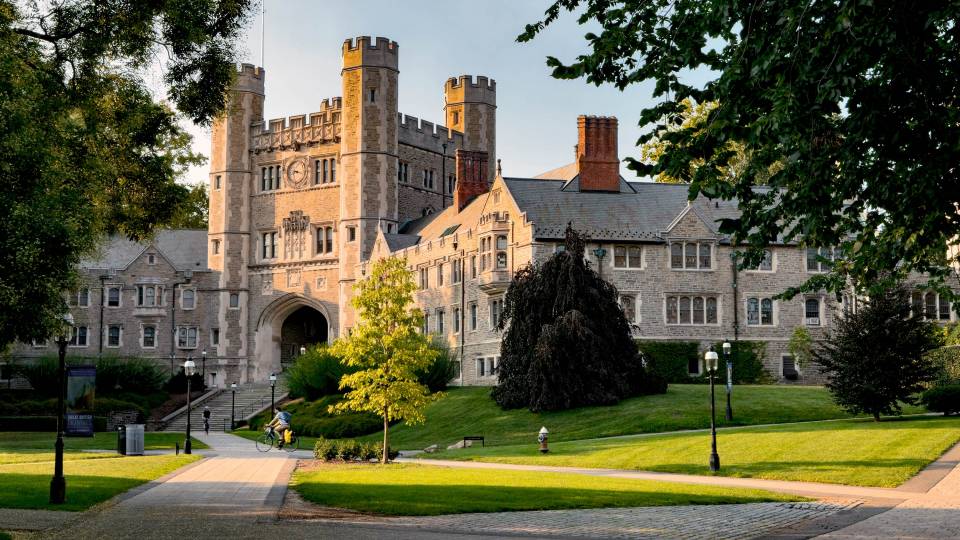The Diversity Working Group
has issued an interim report that describes several initial steps the
University can take to increase the diversity of its staff. The report
also recommends efforts to ensure a long-term commitment to supporting
a staff that reflects a broad range of talents and perspectives.
"We believe that many of the initiatives described ... will have a
positive impact on staff from all backgrounds, not just staff from
minority backgrounds," the report states. "This is a deliberate
strategy that aims to have our entire community embrace a commitment to
diversity, thereby increasing the likelihood not only that cultural
change will occur at Princeton, but that it will be both systemic and
institutionalized."
The Diversity Working Group was formed by President Shirley M. Tilghman
in fall 2004 to identify strategies and potential barriers that affect
the recruitment, hiring, retention and promotion of a diverse workforce
at Princeton. The group has focused its efforts on people of color
among non-faculty employees at all levels.
"The working group has done an excellent job of developing initial
proposals to address some of the important issues they have
identified," Tilghman said. "I am grateful to the members of the group
for the time and careful thought they are devoting to this effort, and
I look forward to receiving their final report later this year."
The group, which encompasses 21 staff members and administrators from a
range of departments, levels and backgrounds, is chaired by Janet
Dickerson, vice president for campus life, and Mark Burstein, executive
vice president. Terri Harris Reed, associate provost for institutional
equity, is serving as executive secretary. The group is working in
conjunction with the provost's office both to analyze areas that
prevent the University from reaching its objectives and to develop
strategies to address those concerns.
Some of the suggestions outlined in the interim report already are
being considered for implementation, according to Burstein. "I expect
that we'll have conversations with the president and the provost to see
if we can implement some of the initiatives in the report as quickly as
possible," he said.
"We found with the Task Force on Health and Well-Being that there were
some small victories that we could achieve even before the final report
was out," added Dickerson, who also co-chaired the health and
well-being group. "This report is in some ways theoretical and in some
ways practical, but to some extent it has to do with embracing this
philosophy and finding a way to enhance communication about our
commitment to diversity. So I could imagine that some of the
communications initiatives might be among those that could be
implemented more quickly."
Initial recommendations
The report begins with an assessment of where Princeton stands, noting
that some progress has been made since the last diversity initiative on
campus. In 1992-93, a report on campus race relations was prepared at
the request of President Harold T. Shapiro. The report was produced
under the leadership of Ruth Simmons, then vice provost at Princeton
and now president of Brown University, with the support of a race
relations working group.
"In response to that report, Princeton implemented specific measures
designed not only to recruit a more diverse student, faculty and staff
population but also to foster a culture in which all could excel," the
interim report states. "These efforts have brought some dividends to
Princeton. Using other Ivy League institutions as a comparison, we have
made progress in attracting and retaining paraprofessional and skilled
trade staff of color. ... On the other hand, we lag in executive and
managerial ranks even as the pool of potential candidates of color has
increased."
For example, 28 percent of all staff hired in 2004 were members of
minority groups. A total of 85 percent of the janitorial and food
service staff hired were members of minority groups, while those
figures were 26 percent for office support staff and 17 percent for
executive and managerial staff.
During the initial phase of its work, the group sought information from
its members and others in the University community on "what they
thought were the beliefs and behaviors that shape the Princeton
experience and impede our ability to recruit and retain employees,"
according to the report.
The report's recommendations fall into three areas: increase the vigor
and visibility of the University's commitment to diversity; create an
environment where all can excel; and enhance the pool of talented
applicants of color.
In the first area, the working group found that although increasing the
diversity of the staff as well as faculty and students is a high
priority for Tilghman and her cabinet, this goal is not widely
understood across the campus.
"If Princeton is to realize its aspiration to become an institution
that embraces and reaps the benefits of a more diverse community, its
entire administration -- and, indeed, the entire University community
-- must work diligently toward achieving a set of shared outcomes," the
report states.
The working group suggests developing a communications plan that might
call for the creation of a diversity Web site and better use of
existing communications vehicles. It also recommends providing more
coordination between the various efforts seeking to increase the
diversity of faculty, students and staff.
The report notes that most of Princeton's peer institutions have more
staff devoted to diversity-related issues and that some have specific
offices concerned with coordinating diversity efforts. The report calls
for the augmentation of senior leadership to deal with diversity,
although it stops short of recommending the creation of a specific
office.
"... the working group was concerned that if our diversity efforts are
associated too closely with any one office we will not appropriately
convey the message that all offices have roles to play in helping to
achieve these goals," the report says.
The second area focuses on creating an environment in which staff
members can feel more connected to the University. One recommendation
is to support affinity groups for employees organized around shared
interests or characteristics such as race, gender, ethnicity or sexual
orientation. Princeton already is home to two groups founded in the
early 1990s: the Princetonians of Color Network and a lesbian, gay,
bisexual and transgender group. The report suggests the University
provide resources and executive sponsorship for such groups; Burstein
already has agreed to sponsor PCN, while Dickerson is sponsoring the
LGBT group.
The report also recommends implementing other programs and activities
that demonstrate an openness to diversity. "... changing the culture of
an institution only happens through sustained multifaceted effort," the
report states. "The University needs to find ways to raise awareness
about the benefits of diversity and to create a more welcoming
community." Suggestions include a more comprehensive employee and new
manager orientation program.
In addition, the report recommends the creation of additional
leadership opportunities for employees: "The working group believes the
University needs to create more opportunities for capable managers of
color to contribute to the institution's overall success in meaningful
ways and to enable entry-level employees to grow professionally at the
University."
Suggestions include:
- assessing the representation of staff of color on existing committees and enhancing representation where needed.
- starting the next phase of Excelling at Princeton, a University-funded program under which staff members are given release time to take classes on campus developed and implemented by the Center for Training and Development at Mercer County Community College. The program is intended to make employees more effective in their current positions as well as to provide the participants with additional skills that will allow them to be more competitive candidates for lead and supervisory positions at the University. Two cohorts of Princeton employees have graduated from the program.
- creating a new University leadership program that is directed toward providing professional development for managers.
The third area identified by the working group -- enhancing the pool of
talented applicants of color -- also focuses on educating managers by
increasing their knowledge of the University's diversity goals and
providing them with additional tools to identify and attract more
applicants of color.
"The University relies on managers in departments to make hiring
decisions," the report states. "This is a strength that the working
group would like to support as opposed to moving toward a more
centralized process. On the other hand, these managers are not at
present succeeding in increasing the University’s diversity."
The working group's recommendations include offering regular training
sessions and providing more centralized support through the Office of
Human Resources. In terms of tools, the group suggests the University
offer a new mortgage program for lower-wage workers to provide them with home ownership opportunities within the local real estate market.
Going forward
The Diversity Working Group is continuing its task this fall and
intends to complete a final report by the end of the academic year.
"... we expect to continue our investigation through a complete review
of our recruitment, hiring and retention data ... and to strengthen the
working group's knowledge through further internal consultation with
additional experts in the field, including discussions with successful
diversity managers working in the private sector," the report states.
"We want to be able to know we're making progress so we want to set
some goals -- short-term and long-term -- and some of them will be
driven by employment data," Reed said. The group also anticipates
conducting a campus survey.
"We want to stress that Princeton is excellent in so many areas, and
this is something that we want to excel at as well," Reed said. "It's
important to have a talented and diverse workforce in the same way we
think it's important to have a talented and diverse faculty and student
body."
The interim report of the Diversity Working Group is available online. Those with comments or suggestions may contact the working group at dwg@princeton.edu.


